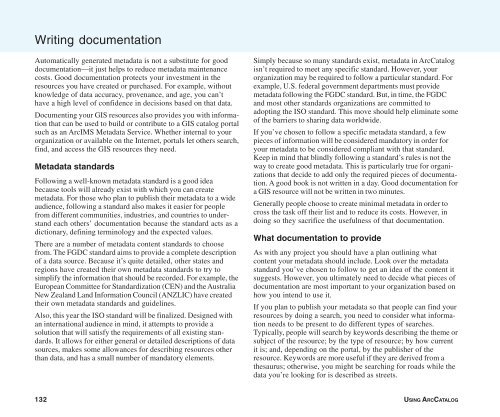Using ArcCatalog
Using ArcCatalog
Using ArcCatalog
Create successful ePaper yourself
Turn your PDF publications into a flip-book with our unique Google optimized e-Paper software.
Writing documentation<br />
Automatically generated metadata is not a substitute for good<br />
documentation—it just helps to reduce metadata maintenance<br />
costs. Good documentation protects your investment in the<br />
resources you have created or purchased. For example, without<br />
knowledge of data accuracy, provenance, and age, you can’t<br />
have a high level of confidence in decisions based on that data.<br />
Documenting your GIS resources also provides you with information<br />
that can be used to build or contribute to a GIS catalog portal<br />
such as an ArcIMS Metadata Service. Whether internal to your<br />
organization or available on the Internet, portals let others search,<br />
find, and access the GIS resources they need.<br />
Metadata standards<br />
Following a well-known metadata standard is a good idea<br />
because tools will already exist with which you can create<br />
metadata. For those who plan to publish their metadata to a wide<br />
audience, following a standard also makes it easier for people<br />
from different communities, industries, and countries to understand<br />
each others’ documentation because the standard acts as a<br />
dictionary, defining terminology and the expected values.<br />
There are a number of metadata content standards to choose<br />
from. The FGDC standard aims to provide a complete description<br />
of a data source. Because it’s quite detailed, other states and<br />
regions have created their own metadata standards to try to<br />
simplify the information that should be recorded. For example, the<br />
European Committee for Standardization (CEN) and the Australia<br />
New Zealand Land Information Council (ANZLIC) have created<br />
their own metadata standards and guidelines.<br />
Also, this year the ISO standard will be finalized. Designed with<br />
an international audience in mind, it attempts to provide a<br />
solution that will satisfy the requirements of all existing standards.<br />
It allows for either general or detailed descriptions of data<br />
sources, makes some allowances for describing resources other<br />
than data, and has a small number of mandatory elements.<br />
Simply because so many standards exist, metadata in <strong>ArcCatalog</strong><br />
isn’t required to meet any specific standard. However, your<br />
organization may be required to follow a particular standard. For<br />
example, U.S. federal government departments must provide<br />
metadata following the FGDC standard. But, in time, the FGDC<br />
and most other standards organizations are committed to<br />
adopting the ISO standard. This move should help eliminate some<br />
of the barriers to sharing data worldwide.<br />
If you’ve chosen to follow a specific metadata standard, a few<br />
pieces of information will be considered mandatory in order for<br />
your metadata to be considered compliant with that standard.<br />
Keep in mind that blindly following a standard’s rules is not the<br />
way to create good metadata. This is particularly true for organizations<br />
that decide to add only the required pieces of documentation.<br />
A good book is not written in a day. Good documentation for<br />
a GIS resource will not be written in two minutes.<br />
Generally people choose to create minimal metadata in order to<br />
cross the task off their list and to reduce its costs. However, in<br />
doing so they sacrifice the usefulness of that documentation.<br />
What documentation to provide<br />
As with any project you should have a plan outlining what<br />
content your metadata should include. Look over the metadata<br />
standard you’ve chosen to follow to get an idea of the content it<br />
suggests. However, you ultimately need to decide what pieces of<br />
documentation are most important to your organization based on<br />
how you intend to use it.<br />
If you plan to publish your metadata so that people can find your<br />
resources by doing a search, you need to consider what information<br />
needs to be present to do different types of searches.<br />
Typically, people will search by keywords describing the theme or<br />
subject of the resource; by the type of resource; by how current<br />
it is; and, depending on the portal, by the publisher of the<br />
resource. Keywords are more useful if they are derived from a<br />
thesaurus; otherwise, you might be searching for roads while the<br />
data you’re looking for is described as streets.<br />
132 USING ARCCATALOG

















